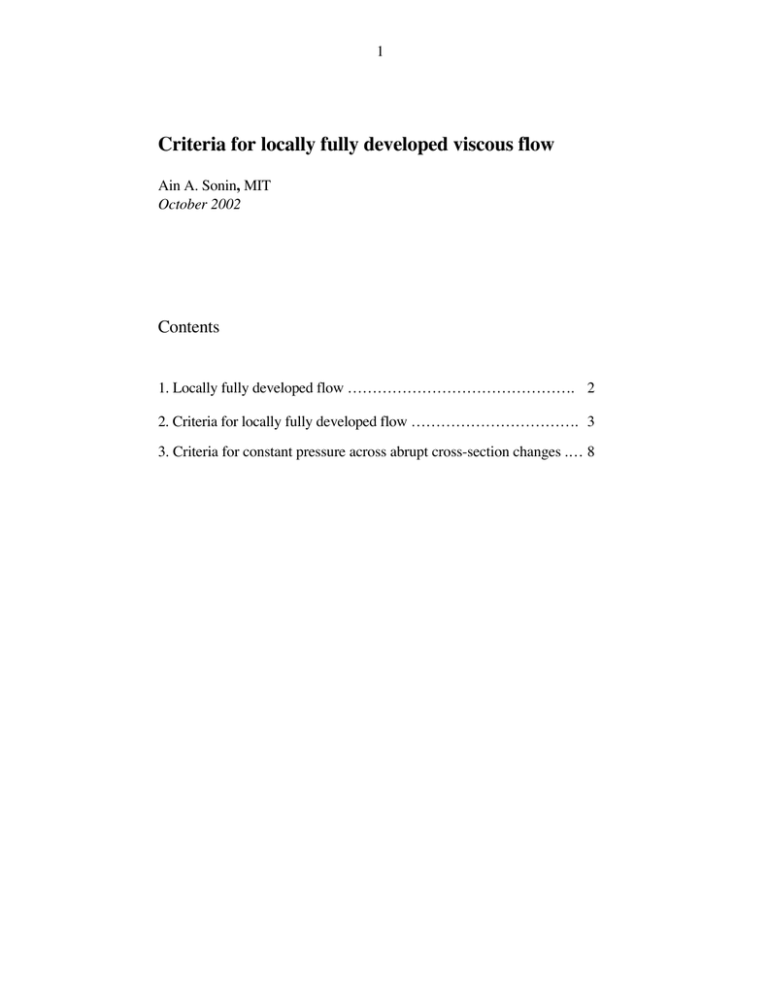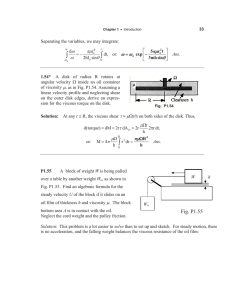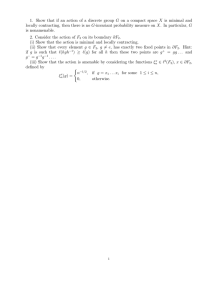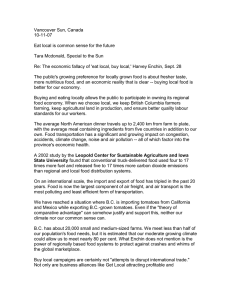Document 13607081
advertisement

1 Criteria for locally fully developed viscous flow Ain A. Sonin, MIT October 2002 Contents 1. Locally fully developed flow ………………………………………. 2 2. Criteria for locally fully developed flow ……………………………. 3 3. Criteria for constant pressure across abrupt cross-section changes .… 8 2 1. Locally fully developed flow Fig. 1: Locally fully developed flow (left) and fully developed flow (right) Consider (as an example) a two-dimensional, laminar, incompressible, viscous flow in a diverging channel, as shown at left in Fig. 1. Let x be the coordinate in the primary flow direction and y the transverse coordinate. The flow is bounded below by a wall and above by either a wall or a free surface, and it may be steady or unsteady, either because the volume flow rate changes with time or because the upper boundary not only depends x but also moves up and down with time, that is, h=h(x,t). The velocity and pressure fields in the channel are determined by the Navier-Stokes equation, ⎛ ∂u ⎛ ∂2 u ∂2 u⎞ ∂u ∂u⎞ ∂P ρ⎜ + u + v =− + µ⎜ 2 + 2 ⎟ ⎝ ∂t ∂x ∂y⎠ ∂x ⎝ ∂x ∂y ⎠ (1) ⎛⎜ ∂v ⎛⎜ ∂2 v ∂ 2v ⎞ ∂v ∂v⎞ ∂P ⎟, + u + v = − ρ +µ + ⎝ ∂t ∂x ∂y⎠ ∂y ⎝ ∂x 2 ∂y 2 ⎠ (2) the mass conservation equation ∂u ∂v + =0, ∂x ∂y (3) and the appropriate boundary and initial conditions. In (1) and (2) P = p + ρgz (4) is a modified pressure in which p is the ordinary static pressure and z the distance measured up against gravity from some chosen reference level (it is 3 not the third Cartesian coordinate that goes with x and y). The term ρgz in (4) accounts for the gravitational body force. The simultaneous presence of the nonlinear inertial terms on the left and the second order viscous terms on the right makes it difficult to solve the Navier-Stokes equation (1)-(2) in the general case. Under certain circumstances, however, all the inertial terms on the left hand sides of (1) and (2), while not zero, are small enough compared with the viscous term to be neglected, and the y-derivative in the viscous term dominates over the xderivative. Under these conditions (1) and (2) simplify to ∂P ∂ 2u 0≈− +µ 2 ∂x ∂y 0≈− ∂P ∂y (5) (6) These equations are similar in form to the equations for a truly fully developed flow. The velocity profile at a station x in this diverging and possibly unsteady flow will thus be identical to the profile in a fully developed flow with the same height, the same boundary conditions at y=0 and y=h, and the same pressure gradient. The flow can be said to be locally fully developed, that is, having at every station x essentially the same velocity profile as a fully developed flow with the same cross-sectional geometry and boundary conditions. For example, if the flow is bounded by solid, immobile walls such that u=0 at y=0 and y=h, the local solution is the familiar parabolic one u≈− h 2 y ⎛ y ⎞ ∂P . 1− 2µ h ⎝ h ⎠ ∂x (7) A dependence on x and t enters implicitly, however, through h=h(x,t) and through the (as yet unknown) axial modified pressure distribution P(x,t). 4 2. Criteria for locally fully developed flow Under what conditions can a flow be considered locally fully developed? If we compare (1) and (2) with (5) and (6), respectively, we see immediately that the criteria are ρ ∂u ∂ 2u << µ 2 ∂t ∂y (8) ρu ∂u ∂ 2u << µ 2 ∂x ∂y (9) ρv ∂u ∂ 2u << µ 2 ∂y ∂y (10) ∂ 2u ∂ 2u << ∂x 2 ∂y 2 (11) where we have implied, but not indicated, that absolute magnitudes are involved in the inequalities. These criteria can be expressed in more useful form by estimating the orders of magnitude of the various derivatives in terms of specified quantities. Let U be a characteristic, or typical, streamwise velocity such that u ≈U (12) where the symbol ≈ in this case stands for order of magnitude, by which we mean an estimate that is correct to within a factor of 3, say, implying that we know the decade in which the quantity's numerical value lies on a logarithmic scale. U might be the average flow speed at the channel's entrance at a particular time, say. Similarly, let h be a characteristic value of the transverse distance h in the problem, e.g. the value at the channel's entrance. Since the dependence on y is expected to be parabolic when (1) serves as a good approximation, we estimate, to order of magnitude, that ∂u U ≈ . ∂y h (13) 5 Next we introduce a characteristic length L in the x direction, such that, inside the channel, ∂u U ≈ ∂x L (14) and a characteristic time τ such that, inside the channel, ∂u U ≈ . ∂t τ (15) Equations (13)-(15) in effect define h, L and τ:these quantities are to be chosen in such a way that the equations represent proper order-of-magnitude estimates for conditions inside most of the channel. In steady flow, τ → ∞, and in fully developed flow in a constant-area duct, L →∞. Consistent with (14) we have ∂ 2u U ≈ ∂x 2 L2 (16) and (13) and the expected (near-) parabolic variation of u with y imply that ∂ 2u U ≈ . ∂y 2 h 2 (17) The transverse velocity component v is obtained from the mass conservation equation (3) as y ∂u dy . ∂x 0 v ≈ −∫ (18) With (14), this yields v≈ U h . L (19) Indicating only the orders of magnitude of all terms except the pressure gradients, we can now write (1) and (2) as 6 ⎛U U 2 U 2 ⎞ ⎛U U ⎞ ∂p + ρ⎜ + ⎟ ≈ − + µ⎜ 2 + 2 ⎟ ⎝L h ⎠ ∂x L L⎠ ⎝τ ⎛U U 2 U 2 ⎞ h ⎛U U ⎞ h ∂p + ρ⎜ + ⎟ ≈ − + µ⎜ 2 + 2 ⎟ ⎝L h ⎠ L ∂y L L ⎠L ⎝τ (20) (21) Based on (20), the criteria for (1) to be represented by (5) are h2 << 1 L2 (22) h2 << 1 ντ (23) ⎛ Uh ⎞ h << 1 . ⎝ ν ⎠ L (24) The same criteria also ensure that (2) reduces to (6). This becomes apparent when we think of (20) and (21) as providing order-of-magnitude estimates for the respective pressure gradients on their right-hand sides. A comparison of (21) and (20) shows that ∂P h ∂P ≈ . ∂y L ∂x (25) Since the pressure difference between two points in a particular direction is the gradient multiplied by the distance in that direction, (25) shows that the magnitude of the pressure change across the channel is of the order of (h/L)2 times the pressure change in the streamwise direction over the distance L. In other words, if (h/L)2<<1, the pressure changes across the channel can be neglected, and (6) is a good approximation. We conclude that (22)-(24) are the necessary and sufficient conditions for the flow inside the channel to be locally fully developed. Equation (22) is equivalent to (11). It implies that the angle of divergence of the channel is everywhere small, which has the consequence that (i) the second derivative of u with respect to y is the dominant viscous 7 term, and (ii) the pressure is approximately hydrostatically distributed⎯that is, the modified pressure P = p + ρgz , is constant, where z points up against gravity⎯at any station x. Equation (23) is equivalent to (8). It implies that the flow is quasi-steady in the sense that the time-dependent term in the equation of motion is negligible, even if the velocity field turns out depend on time via timedependent boundary conditions. Physically, (23) states that the characteristic time τ associated with significant temporal velocity change must be very long compared with the time h2/ν for the velocity profile to diffuse to a steady-state shape across the channel. Equation (24) is equivalent to (9) and (10) and implies that both convective acceleration terms (they are of the same order) can be neglected compared with the dominant viscous term. Note that the requirement is not that the Reynolds number Uh/ νbe small, but that the product of the Reynolds number and h/L be small, which can be satisfied even at large Reynolds numbers if h/l is sufficiently small. When L>>h, the proper measure of the ratio of the inertial terms relative to the dominant viscous term is not the Reynolds number Re = ρUh µ based on h, but that number times h/L. Equations (22)-(24) apply in many practical situations that involve viscous flow in narrow gaps or thin layers, lubrication problems being perhaps the most notable. One final question arises about the inequalities (22)-(24). How small do the left hand sides have to be relative to unity for the flow to be locally fully developed? Numbers like 10-4 or 10-2 seem safe enough, but what about 0.1 or even 1? We must remember that the present analysis is very rough, correct only to order-of-magnitude. It cannot answer this question with precision. For one thing, the answer clearly depends on how we choose the characteristic values U, h, L and τ, which may be done in different ways. There is no reason to assume that even values like 1 or 3 are necessarily too large, although 102 would most certainly be suspect. A precise test of the validity of the locally fully developed flow assumptions can only be obtained by means of a self-consistency test, where one substitutes the locally fully developed solution for the velocity components u(x,y,t) and v(x,y,t) into (8)-(11) and obtains criteria for when the ratios of the left and right hand sides are all below 0.01, say, or whatever accuracy one desires the locally fully developed solution to have. A selfconsistency check is always the preferred way of answering the question of 8 what is small enough, but it can be done only on a case by case basis after a particular solution has been obtained. Equations (22)-(24) serve as an adequate estimate, however, and are conveniently expressed in general terms. They suffice if the estimates come out truly small so that there is little doubt of the assumptions being satisfied. 3. Constant pressure across abrupt changes of cross-section Equation (22) is never satisfied in regions where the flow field diverges or converges sharply (that is, h changes by its own magnitude in a streamwise distance of order h). A few such regions often appear in systems where the flow is otherwise locally fully developed: there is usually an entrance region from a reservoir to a channel, for example, and there may be one or several locations where the channel cross-section changes abruptly. The locally fully developed flow equations cannot be applied through these regions. How does one deal with them? We shall show that if localized regions of abrupt change occur in systems where the flow is otherwise locally fully developed, one can in most cases bridge the gap across the offending regions simply by applying mass conservation and assuming that pressure is constant across them, provided those regions are very short compared with the segments where the flow is locally fully developed. That pressure invariance should be an appropriate approximation is not obvious, for the Reynolds number based on h can be large in such flows, and Bernoulli pressure drops of the order of ρU 2 2 might be expected, where U is the mean flow speed. Consider the example in Fig. 2, where two reservoirs at pressures that differ by ∆p are connected by a channel of two segments, one with length L1 and height h1 and the other with length L2 and height h2 , that connect two reservoirs. We are to find the value ∆p that corresponds to a given volume flow rate Q. Let us assume that the flow is locally fully developed [(22)-(24) are satisfied] inside each of the two segments, but not near the entrance region (a) and in transition region (b)-(c) between the segments, where significant area and velocity changes occur over a distance of a few h, say, and (22) is clearly violated. The viscous pressure drop in each of the two fully developed flow regions can be obtained from the solution for fully developed flow as 9 Δpviscous = 12µUL h2 (26) The pressure drop at the entrance and across the transition region between the two segments depends on whether the Reynolds number is small or large. If the Reynolds number is small, we estimate it from (26) with L≈h, assuming the transition occurs in a distance of at most a few h; if it is large, we claim it cannot exceed the maximum Bernoulli drop. Thus, Fig. 2: Pressure distribution under (a) inertia-dominated, (b) intermediate and (c) highly viscous (locally fully developed) conditions. 10 12µUh Δptransitions ≈ h 2 Δptransitions ≈ ρU 2 2 if Re = ρUh <1 µ (27) if Re = ρVh >1 µ (28) where the second represents if anything an overestimate. From (26)-(28) we obtain Δptransitions 1 h ≈ Δpviscous 12 L if ρUh <1 µ (29) Δptransitions 1 ⎛⎜ ρUh ⎞ h ≈ 12 ⎝ µ ⎠ L Δpviscous if ρVh >1 µ (30) It is now clear that the criteria h << 1 L (31) ⎛⎜ ρUh⎞ h << 1 ⎝ µ ⎠L (32) h2 << 1 ντ (33) permit two significant simplifications: (i) (ii) the flow in the channel segments may be considered locally fully developed, and the pressure may be taken as constant across abrupt changes of cross section. Note that the requirement (31) for constant pressure across area changes is more severe than (22), which refers to the flow inside the channel sections only. 11 Fig. 2 shows how the pressure distribution in the channel changes depending on the modified Reynolds number ⎛ ρUh⎞ h Re′ = ⎜ , ⎝ µ ⎠L (34) assuming steady flow and h<<L. When Re′>>1 (Fig. 2a), inertial effects dominate and the pressure drop is accounted for by the Bernoulli drops at the two contractions, the viscous pressure drops being negligible by comparison. In the opposite limit Re′<<1 (Fig. 2c) the flow is locally fully developed [(31)-(33) apply]. The viscous pressure drops in the channels account for virtually all of Δp, and the Bernoulli drops are negligible by comparison. Fig. (2b) depicts an intermediate regime where Re’≈O(1), and the inertial (Bernoulli) and viscous pressure drops are of the same order. MIT OpenCourseWare http://ocw.mit.edu 2.25 Advanced Fluid Mechanics Fall 2013 For information about citing these materials or our Terms of Use, visit: http://ocw.mit.edu/terms.


